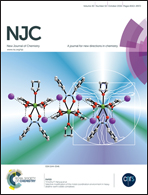A europium(iii)-based metal–organic framework as a naked-eye and fast response luminescence sensor for acetone and ferric iron†
Abstract
A europium(III)-based metal–organic framework {[Eu(bpda)1.5]·H2O}n Eu–BPDA (BPDA = biphenyl-2,2′-dicarboxylic acid) has been solvothermally synthesized and structurally characterized. The MOF has a three-dimensional architecture and shows bright red-emission even in water solution. It is found that the MOF exhibits a significant fluorescence quenching effect toward acetone. In particular, it possesses a fast response of 5 s, high sensitivity with an EC50 of 0.028 vol%, which is below the occupational exposure limit of acetone stipulated by the American Conference of Governmental Industrial Hygienists (ACGIH), naked-eye visualization and easy recycling. Moreover, it could also be used as an excellent naked-eye fluorescence sensor for Fe3+ ions with a Stern–Volmer constant KSV = 1.25 × 104 L mol−1 and unusually high selectivity in pure water. The fluorescence quenching mechanism for acetone and Fe3+ ions was also investigated, giving a rare example that worked as an efficient dual sensor for acetone and Fe3+ detection.


 Please wait while we load your content...
Please wait while we load your content...